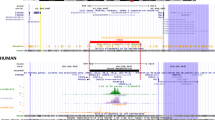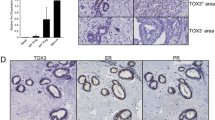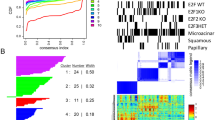Abstract
We hypothesize that elevation of nm23-H1 metastasis suppressor gene expression in micrometastatic tumor cells may reduce their subsequent colonization and invasion, and induce differentiation, with a clinical benefit. This report presents the first analysis of the nm23-H1 promoter to identify sites which can increase its transcription. Deletion mapping of a 2.1 kb nm23-H1 promoter fragment tethered to a reporter gene identified three regions involved in its differential expression levels among a panel of human breast carcinoma cell lines: a 195 bp NheI-XbaI fragment responsible for basal expression levels, a 248 bp AvrII-NheI fragment which contributed to the elevated nm23-H1 expression observed in the high expressing cell lines, and a 544 bp AvrII fragment containing an inhibitory element. Examination of the 248 bp AvrII-NheI fragment revealed the unexpected presence of three transcription factor binding sites (MAF/Ets, CTF/NF1 half site and ACAAAG enhancer) previously identified in the MMTV-LTR, and in WAP and milk gene promoters, proposed to mediate mammary-specific gene expression. Mutation of the three sites, individually or together, resulted in two-fold reductions in reporter gene expression. As controls, the same panel of mutations caused a different pattern of reporter gene expression in a non-mammary cell line, and mutation of another nearby site was without effect on nm23-H1. Our data identify a complex regulatory pattern for nm23-H1 transcription, and suggest that a mammary-specific cassette of transcription factors contribute to its elevated expression
Similar content being viewed by others
References
Yoshida B, Sokoloff M, Welch D et al. Metastasis-suppressor genes: A review and perspective on an emerging field. J Natl Cancer Inst 2000; 92: 1717–30.
Yang X, Wei L, Tang C, et al. KAI1 protein is down-regulated during the progression of human breast cancer. Clin Cancer Res 2000; 6: 3424–9.
Cropp C, Lidereau R, Leone A et al. NME1 protein expression and loss of heterozygosity mutations in primary human breast tumors. J Natl Cancer Inst 1994; 86: 1167–9.
Hartsough M, Steeg P. Nm23/Nucleoside diphosphate kinase in human cancers. J Bioenerg Biomem 2000; 32: 301–8.
Russell R, Pedersen A, Kantor J et al. Relationship of nm23 to proteolytic factors, proliferation and motility in breast cancer tissues and cell lines. Br J Cancer 1998; 78: 710–7.
Miyazaki H, Fukuda M, Ishijima Y et al. Overexpression of nm23-H2/NDP Kinase B in a human oral squamous cell carcinoma cell line results in reduced metastsis, differentiated phenotype in the metastatic site, and growth factor-independent proliferative activity in culture. Clin Cancer Res 1999; 5: 4301–7.
Parhar RS, Shi Y, Zou M et al. Effects of cytokine mediated modulation of Nm23 expression on the invasion and metastatic behavior of B16F10 melanoma cells. Int J Cancer 1995; 60: 204–10.
Baba H, Urano T, Okada K et al. Two isotypes of murine nm23/Nucleoside Diphosphate Kinse, nm23-M1 and nm23-M2, are involved in metastatic suppression of a murine melanoma line. Cancer Res 1995; 55: 1977–81.
Fukuda M, Ishii A, Yasutomo Y et al. Metastatic potential of rat mammary adenocarcinoma cells associated with decreased expression of nucleoside diphosphate kinase/nm23: Reduction by transfection of NDP Kinase a isoform, an nm23-H2 gene homolog. Int J Cancer 1996; 65: 531–7.
Bhujwalla Z, Aboagye E, Gilles R et al. Nm23-transfected MDAMB-435 human breast carcinoma cells form tumors with altered phospholipid metabolism and pH: A 31P nuclear magnetic resonance study in vivo and in vitro. Magnetic Res Med 1999; 41: 897–903.
Leone A, Flatow U, King CR et al. Reduced tumor incidence, metastatic potential, and cytokine responsiveness of nm23-transfected melanoma cells. Cell 1991; 65: 25–35.
Leone A, Flatow U, VanHoutte K et al. Transfection of human nm23-H1 into the human MDA-MB-435 breast carcinoma cell line: Effects on tumor metastatic potential, colonization, and enzymatic activity. Oncogene 1993; 8: 2325–33.
Miele ME, Rosa ADL, Lee JH et al. Suppression of human melanoma metastasis following introduction of chromosome 6 is independent of NME1 (nm23). Clin Exp Metastasis 1997; 15: 259–65.
Tagashira H, Hamazaki K, Tanaka N et al. Reduced metastatic potential and c-myc overexpression of colon adenocarcinoma cells (Colon 26 line) transfected with nm23-R2 rat nucleoside diphosphate kinase a isoform. Int J Mol Med 1998; 2: 65–8.
Bemis L, Schedin P. Reproductive state of rat mammary gland stroma modulates human breast cancer cell migration and invasion. Cancer Res 2000; 60: 3414–8.
Kantor JD, McCormick B, Steeg PS et al. Inhibition of cell motility after nm23 transfection of human and murine tumor cells. Cancer Res 1993; 53: 1971–3.
MacDonald N, Freije J, Stracke M et al. Site directed mutagenesis of nm23-H1: Mutation of proline 96 or serine 120 abrogates its motility inhibitory activity upon transfection into human breast carcinoma cells. J Biol Chem 1996; 271: 25107–116.
Howlett AR, Petersen OW, Steeg PS et al. A novel function for Nm23: Overexpression in human breast carcinoma cells leads to the formation of basement membrane and growth arrest. J Natl Cancer Inst 1994; 86: 1838–44.
Liu F, Qi H-L, Chen H-L. Effects of all-trans retinoic acid and epidermal growth factor on the expression of nm23-H1 in human hepatocarcinoma cells. J Cancer Res Clin Oncol 2000; 126: 85–90.
Mehta R, Bratescu L, Graves J et al. Differentiation of human breast carcinoma cells by a novel vitamin D analog: 1 alpha-hydroxyvitamin D-5. Int J Oncol 2000; 16: 65–73.
Hartsough M, Clare S, Mair M et al. Elevation of breast carcinoma nm23-H1 metastasis suppressor gene expression and reduced motility by DNA methylation inhibition. Cancer Res 2001; in press.
Mink S, Hartig E, Jennewein P et al. A mammary cell-specific enhancer in mouse mammary tumor virus DNA is composed of multiple regulatory elements including binding sites for CTF/NF1 and a novel transcription factor, mammary cell-activating factor. Mol Cell Biol 1992; 12: 4906–18.
Dignam J, Lebovitz R, Roeder R. Accurate transcription initiation by RNA polymerase II in a soluble extract from isolated mammalian nuclei. Nucleic Acids Res 1983; 11: 1475–89.
DeLaRosa A, Mikhak B, Steeg P. Identification and characterization of the promoter for the human metastasis suppressor gene nm23-H1. Archives Med Res 1996; 27: 395–401.
Boussif O, Lezoualch F, Zanta M et al. Proc Natl Acad Sci USA 1995; 92: 7297–301.
Thompson E, Paik S, Brunner N et al. Association of increased basement membrane invasiveness with absence of estrogen receptor and expression of vimentin in human breast cancer cell lines. J Cell Physiol 1992; 150: 534–44.
Chen H-C, Wang L, Banerjee S. Isolation and characterization of the promoter region of human nm23-H1, a metastasis suppressor gene. Oncogene 1994; 9: 2905–12.
Okada K, Urano T, Baba H et al. Independent and differential expression of two isotypes of human Nm23: analysis of the promoter regions of the nm23-H1 and H2 genes. Oncogene 1996; 13: 1937–43.
Welte T, Garimorth K, Phillipp S et al. Involvement of Ets-reglated proteins in hormone-independent mammary cell-specific gene expression. Eur J Biochem 1994; 223: 997–1006.
Malewski T, Zweirzchowski L. Changes of tissue-specific transcription factors in the rabbit mammary gland during pregnancy and lactation. Tsitol Genet 1997; 31: 58–69.
Lakso M, Steeg PS, Westphal H. Embryonic expression of Nm23 during mouse organogenesis. Cell Growth Diff 1992; 3: 873–9.
Sharrocks AD, Brown AL, Ling Y et al. Int J Biochem Cell Biol 1997; 29: 1371–87.
Monte D, Baert JL, Laget MP et al. Ann Endocrinol (Paris) 1995; 56: 547–51.
Author information
Authors and Affiliations
Rights and permissions
About this article
Cite this article
Ouatas, T., Clare, S.E., Hartsough, M.T. et al. MMTV-associated transcription factor binding sites increase nm23-H1 metastasis suppressor gene expression in human breast carcinoma cell lines. Clin Exp Metastasis 19, 35–42 (2002). https://doi.org/10.1023/A:1013897022827
Issue Date:
DOI: https://doi.org/10.1023/A:1013897022827




